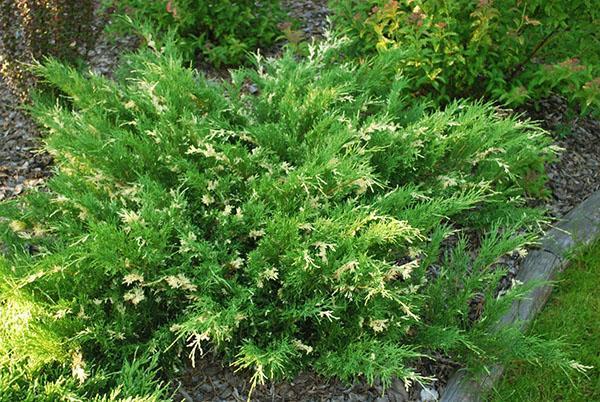Choosing Cossack juniper varieties for giving
 Juniper is an ornamental plant that is widely used in landscape design. There are about 80 varieties of this culture. They are used to decorate home gardens and municipal parks.
Juniper is an ornamental plant that is widely used in landscape design. There are about 80 varieties of this culture. They are used to decorate home gardens and municipal parks.
Juniper belongs to the cypress family. Like all conifers, this decorative culture is evergreen. Juniper varieties are divided into three distinct subgroups:
- sebina (Cossack);
- oxycedrus (thorny);
- cyreocedrus (Chinese).
All junipers look good in different landscape compositions. They are planted on alpine slides as the first tier. Thorny junipers are tall trees. Chinese junipers, the most common species in Russia. They are represented by tall shrubs (see photo of juniper).
Let's consider the Cossack juniper varieties in more detail. They are well suited for planting in garden plots in flower beds and flower beds.
Sebina variegata
Variegata Cossack juniper grows up to 1 m in height. It is unpretentious in the composition of the soil and takes root in the ground with different PH levels. The shrub develops well in a lighted area. Slightly acidic soils are preferred. In such soil, the juniper reaches 2 m in diameter.
The appearance of this plant makes Cossack juniper Variegata is an excellent option for the second tier of landscape composition. The shrub is symmetrical, keeps its shape well after cutting. Without forming, the bush forms a flat oval.
The tips of the juniper needles are bright, yellow. The shoots gradually acquire a light green hue, and closer to the root they become dark green.
Although this juniper variety is shade-tolerant, it is best to plant it in a sunny place. So the plant will acquire a bright saturated color.
Variety Cossack
The juniper variety Cossack is the ancestor of the subspecies of the same name. This plant is a short bush with bright green needles. It releases the largest amount of phytoncides into the environment.
Many consider this variety to be sprawling, but this is not entirely true. The fact is that this juniper multiplies by rooting its own branches, so several plants can grow together. The distance between the bushes should be more than 1 m.
It is inferior in its decorative qualities to the previous variety, but it is much easier to care for it. You do not need to fertilize under the bush. Water the branches once a week. In winter, clean off the snow from them, as junipers can suffer from burns.